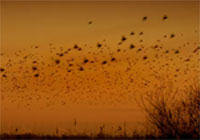 I’ve always been fascinated by crowds — how they form, why they form, what influences them, and what, in turn, they have the ability to influence. I’ve also always tried to differentiate between crowds and communities, the latter being a more “refined” version of a crowd. Communities have purpose, and common bonds that bind the individuals together. So when I came across a couple of choice documentaries recently, that explored the nature, and science, of crowd/community behavior (and what it means as an individual within a crowd or community) the questions started flying. Fast.
I’ve always been fascinated by crowds — how they form, why they form, what influences them, and what, in turn, they have the ability to influence. I’ve also always tried to differentiate between crowds and communities, the latter being a more “refined” version of a crowd. Communities have purpose, and common bonds that bind the individuals together. So when I came across a couple of choice documentaries recently, that explored the nature, and science, of crowd/community behavior (and what it means as an individual within a crowd or community) the questions started flying. Fast.
STARLINGS and MURMURATIONS
I came across a brilliant documentary by Marcus du Sautoy, part of the BBC’s “The Code” series, in which he mathematically explains the amazing”Black Sun” murmurations that starlings form every year on their annual migration. Watching tens of thousands, perhaps a hundred thousand or more, fly in seemingly random, yet fluid, ever-changing pattern was both amazing to watch, but it also begged the question “how”? It turns out, as Marcus, explains, that you can mathematically recreate a murmuration of starlings with three basic rules: all birds should fly at approximately the same speed, they should stay close to their neighbors, and they should avoid predators (danger).
If you follow these three simple rules, it turns out that each starling need only keep track of (be influenced by) their seven closest neighbors. And those seven neighbors are constantly changing as the murmuration morphs in flight.
Might not the same basic rules apply to human behavior and individuals within a community or crowd?
INDIVIDUALS and CONFORMITY
After watching the BBC documentary, I stumbled across a great show on the Discovery Channel – Head Games. In this particular episode, they were delving into the nature of human conformity – could they make people conform to a belief or behavior that they inherently knew was wrong or incorrect?
During their experiments, they were able to convince a group of individuals that a snake was sitting high up in a tree — so much so that these individuals went on to convince others that there was indeed a snake in the tree. They described its shape, its color, its movements. But there was no snake.
During a second test, they were able to get a group of people to follow a red line through a museum — even though the red line took them away from the main exhibits (at one point having them actually walk in a circle around a pole).
After digging a bit deeper, I came across a study referenced in Science Daily that demonstrated an innate predisposition in humans to need to conform, as well as a predisposition in certain people (based on the size of certain regions of the brain) to have a higher-than-normal tendency to need to conform. To belong. To be safe. In other words, to not stand out or put themselves at risk.
THE QUESTIONS
After viewing the videos, digging deeper into the “conformity predisposition” and tossing the ideas about, a series of questions began to take shape…
- At what point, if ever, does a group of individuals become a crowd (with collective influence and behavior)?
- Can a group influence you in the same way that an individual does? (Can they be one of your “7”)?
- At what point does conformity override our individual opinions and actions?
- At what point does a crowd attain the characteristics, and influence, of an individual (if ever)?
- Does conformity result in a faster shift in our opinions? Or do we still focus on our closest friends to define our behavior?
If you have any answers, I’d love to hear them. Let’s compare some notes. I’m far from done with this subject.
